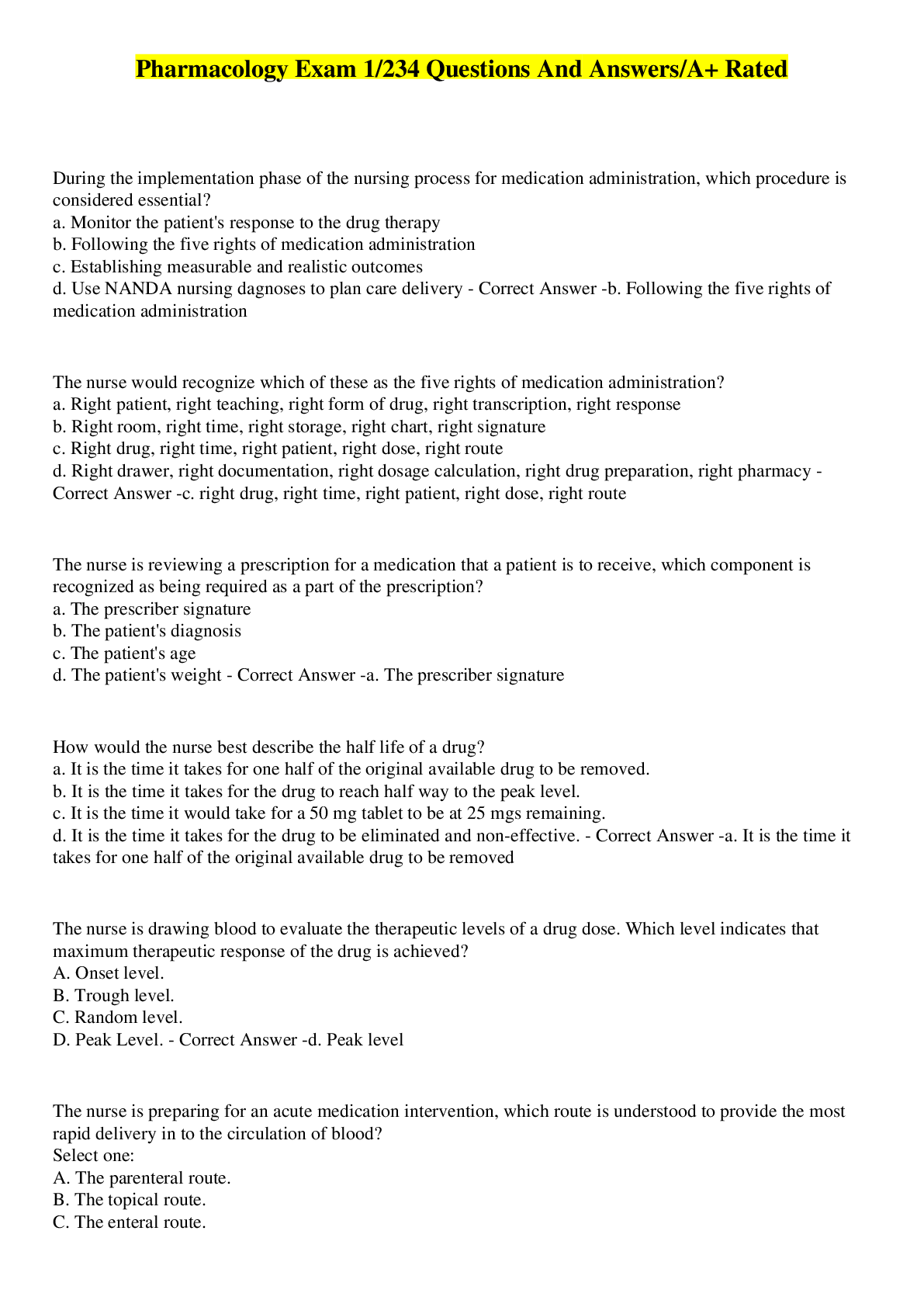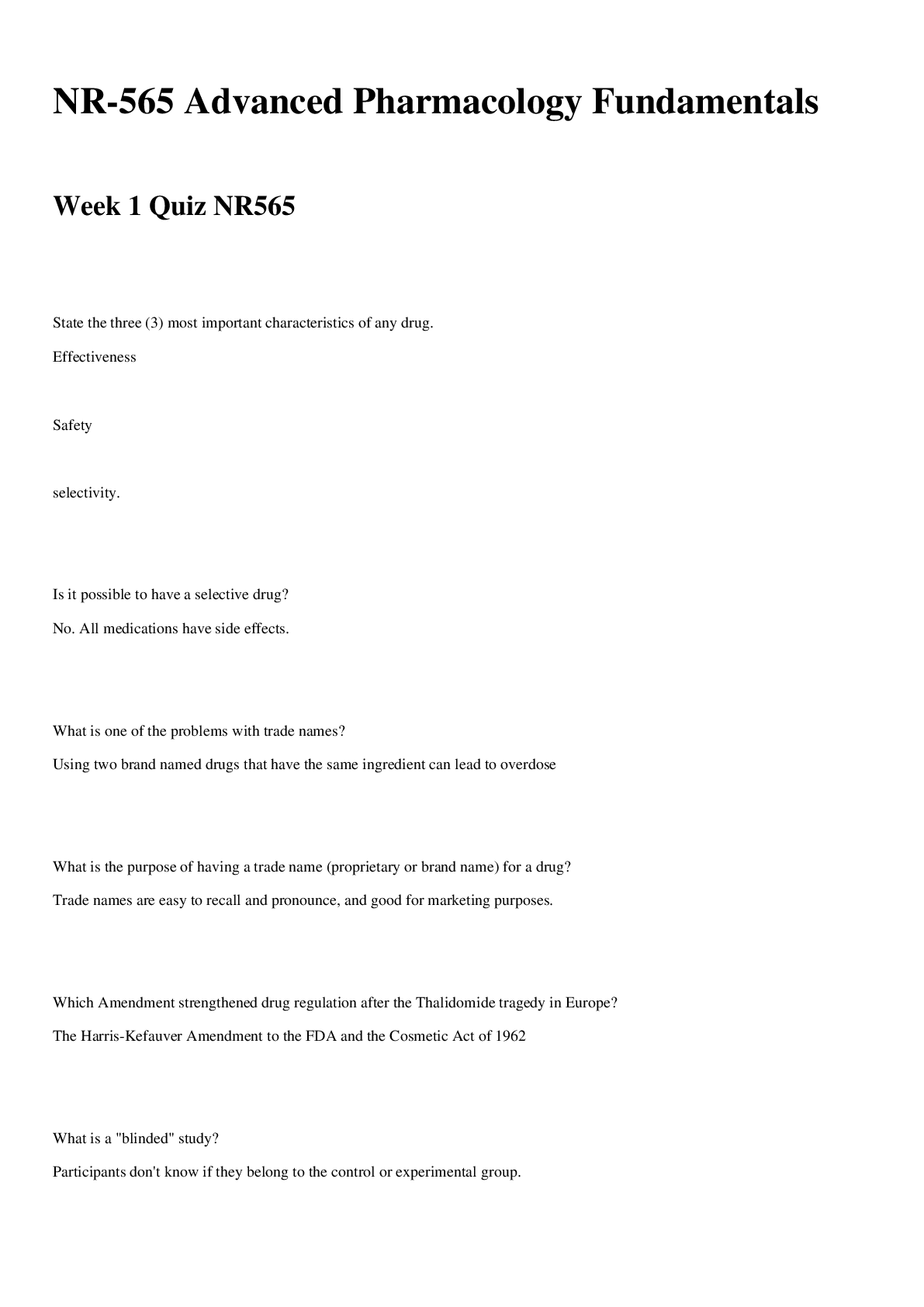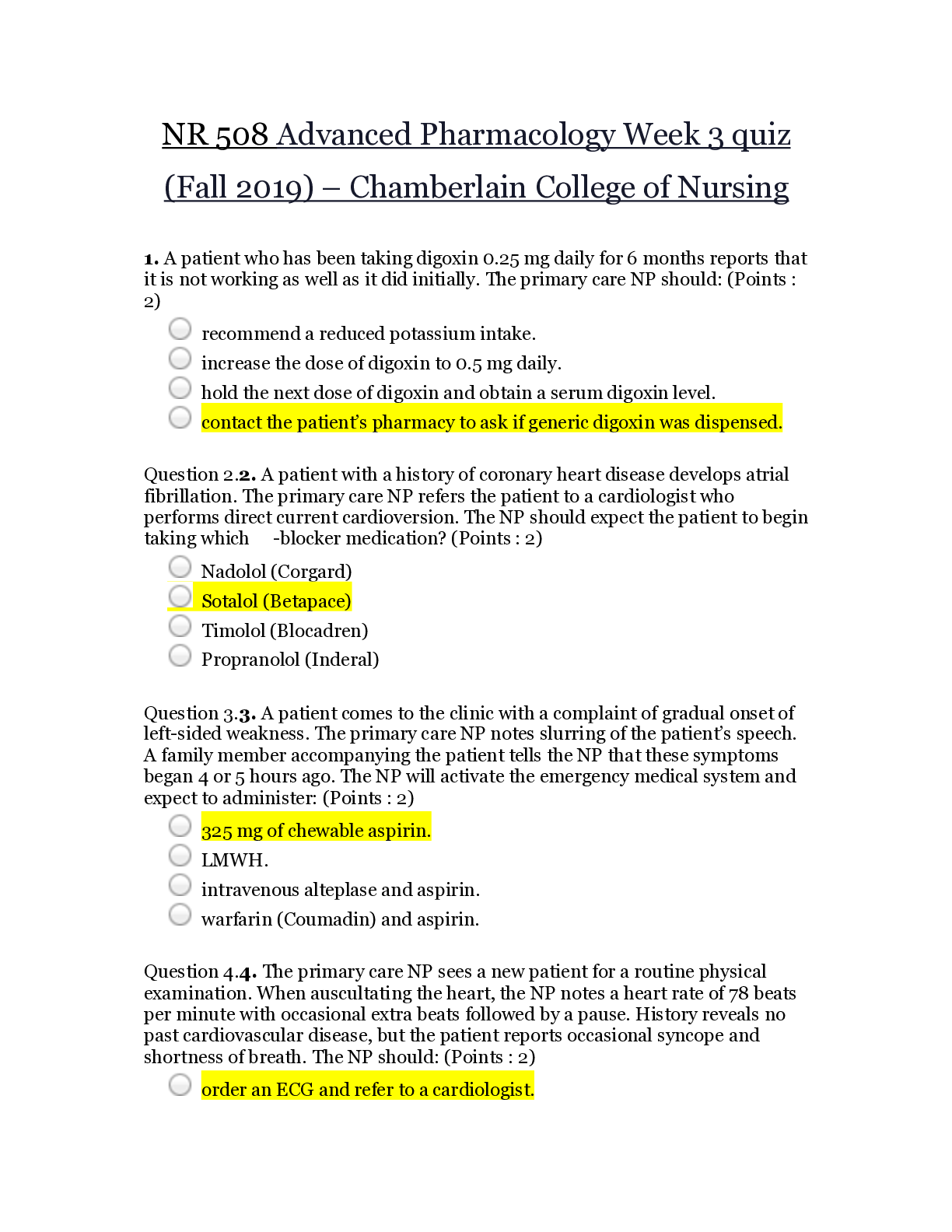*NURSING > EXAM > Mental Health Study Guide 1-2 (updated 2020) – Chamberlain College of Nursing | Mental Health Stud (All)
Mental Health Study Guide 1-2 (updated 2020) – Chamberlain College of Nursing | Mental Health Study Guide 1-2 (updated 2020)
Document Content and Description Below
Mental Health Study Guide 1-2 (updated 2020) – Chamberlain College of Nursing Mental Health Study Guide 1: Chapter 1 Stress: may be viewed as an individual's reaction to any change that requires ... an adjustment or response, which can be physical, mental, or emotional. Stressor: A biological, psychological, social, or chemical factor that causes physical or emotional tension and may be a factor in the etiology of certain illnesses. Adaption: includes responses directed at stabilizing internal biological processes and psychological preservation of self-identity and self-esteem. - Adaptive responses are seen as positive, correlates with healthy responses - Maladaptive responses are seen as negative/ unhealthy responses. 3 types of Stress: 1. Stress as a Biological Responses - “Fight or Flight” Syndrome also known as General Adaption Syndrome (has 3 stages) o Alarm Reaction Stage: Physiological responses are initiated. o Stage of Resistance: Person attempts to adapt via physiological responses. If they adapt successfully, they are able to prevent or delay 3rd stage and physiological responses may disappear. If not 3rd stage occurs. o Stage of Exhaustion: When person has been exposed to stress for to long and the body no longer has energy to adapt. Can causes headaches, mental disorders, coronary artery disease, even death if not reversed. 2. Stress as an Environmental Event - Creates change in the life pattern of the individual o These changes can be positive (personal achievement) or negative (being fired from a job) - Requires significant adjustment in lifestyle—EX. Adjusting to the loss of a loved one - Taxes available personal resources—a person may need support they didn’t usually need/or need more. 3. Stress as a Transaction between the individual and the environment - Relationship between the individual and the environment. Personal characteristics and the nature of the environmental event are considered. - Precipitating Event: a stimulus arising from the internal or external environment and perceived by the individual in a specific manner. - Cognitive Appraisal: is an individual's evaluation of the personal significance of the event or occurrence. o - - - - - - - - - - - - - - - - - - - - - - - - - - - - - - Awareness: to become aware of the factors that create stress and the feelings associated with a stressful response. - Relaxation, Meditation, Pets, and Music - Interpersonal communication with caring other: “talking the problem out” - Problem solving: looking at the problem objectively and make a plan to solve it. Chapter 2 Incomprehensibility: the inability of the general population to understand the motivation behind the behavior. Cultural relativity: understandings of the general population are on the individual's own particular culture/society. - Behavior that is considered “normal” and “abnormal” is based on one's cultural or societal norms. So if a certain society views a behavior as “abnormal” they are more likely to be labeled as mentally ill compared to another society which may view it as “normal.” Peplau’s 4 levels of Anxiety 1. Mild Anxiety: occurs as a response to events of day-to-day living - It sharpens the senses, increases motivation for productivity, increases the perceptual field, and results in a heightened awareness of the environment. - Learning is enhanced and the individual is able to function at his or her optimal level. - Coping Mechanisms: Yawning, Laughing, Eating, Cursing, Nail biting, Fidgeting, foot swinging, talking to someone close to you, day dreaming, crying, sleeping and etc. 2. Moderate Anxiety: As anxiety increases, ability to cope decreases. - Person is less alert to events occurring in the environment, attention span and ability to concentrate decrease. - Assistance with problem solving may be required. - Increased muscular tension and restlessness are evident. - Physical characteristics: increased HR, RR, Perspiration, speech rate/volume/pitch, and gastric discomfort. 3. Severe Anxiety: At this level of anxiety, the person’s attention span is extremely limited, and has difficulty completing even the simplest task. - Concentration centers on one particular detail only or on many extraneous details - Physical symptoms appear: headaches, palpitations, insomnia, trembling, diarrhea, urinary frequency, tachycardia, and nausea. - Emotional symptoms appear: confusion, dread, horror…may be evident o Intense need to relieve the anxiety - Basically all overt behavior is aimed at relieving the anxiety. - Neurosis: excessive anxiety that is either expressed as is or as a defense mechanism o Common symptoms: phobias, sexual dysfunction, compulsion/obsession o Characteristics: person is aware of maladaptive behaviors and distress, feel helpless, don’t lose contact w/ reality, BUT unaware of possible psychological causes of distress. 4. Panic Anxiety: the most intense state of anxiety, the individual is unable to focus on even one detail in the environment. - Misperceptions are common, and a loss of contact with reality may occur o Person may experience hallucinations or delusions - Human functioning and communication with others is ineffective - Person may feel terror and individuals may be convinced that they have a life-threatening illness or fear that they are “going crazy,” are losing control, or are emotionally weak. o May exhibit bizarre behaviors like: shouting, screaming, running around wildly, clinging to anyone/thing that provides sense of safety and/or extreme withdrawal. Can eventually lead to psychosis. - Physical and emotional exhaustion and can be a life-threatening situation if a person is in this state for a prolonged amount of time. - Physical characteristics: dilated pupils, labored breathing, severe trembling, diaphoresis/pallor, muscular incoordination, incoherence/unable to verbalize. - Psychosis: characterized by impaired reality via hallucinations, delusions, disorganized, catatonic behavior o - - - - - - - - - - - - - - - - - - - - - - - - - - - - - - - - - - - - - - - - - Pt. can be anger or excessively nice to nurse. Can affect therapeutic communication. Intervention: help pt. sort out past and present/ redefine nurse/pt. relationship. o Countertransference: nurse transfers their emotional/behavioral response unto the pt. EX. Nurse encourage pt. to be dependent, starts a personal/social relationship with pt., nurse defends client’s behavior to staff, etc. Nurse may be unaware that this is occurring. Intervention: nurse should be assisted when caring for pt. and should be evaluated after sessions with client. - Termination phase: Therapeutic conclusion to relationship o This stage should start during pre-interaction phase and continue until this phase. o Nurse and client should express feelings about termination. Encourage pt. that it is acceptable to have to be sad/etc due to ending of relationship. Chapter 8 Therapeutic Communications • Using silence allows the client to take control of the discussion, if he or she so desires. • Accepting conveys positive regard. • Giving recognition is acknowledging, indicating awareness. • Offering self is making oneself available. • Giving broad openings allows the client to select the topic. • Offering general leads encourages the client to continue. • Placing the event in time or sequence clarifies the relationship of events in time. • Making observations is verbalizing what is observed or perceived. • Encouraging description of perceptions is asking client to verbalize what is being perceived. • Encouraging comparison asks the client to compare similarities and differences in ideas, experiences, or interpersonal relationships. • Restating lets the client know whether an expressed statement has or has not been understood. • Reflecting directs questions or feelings back to client so that they may be recognized and accepted. • Focusing is taking notice of a single idea or even a single word. • Exploring is delving further into a subject, idea, experience, or relationship. • Seeking clarification and validation strives to explain what is vague and searches for mutual understanding. • Presenting reality clarifies misconceptions that client may be expressing. • Voicing doubt expresses uncertainty as to the reality of client’s perception. • Verbalizing the implied is putting into words what client has only implied. • Attempting to translate words into feelings is putting into words the feelings the client has expressed only indirectly. • Formulating a plan of action strives to prevent anger or anxiety from escalating to an unmanageable level the next time the stressor occurs. Non-Therapeutic Communications • Giving reassurance may discourage client from further expression of feelings if client believes the feelings will only be belittled. • Rejecting is refusing to consider client’s ideas or behavior. • Giving approval or disapproval implies that the nurse has the right to pass judgment on the “goodness” or “badness” of client’s behavior • Agreeing/disagreeing implies that the nurse has the right to pass judgment on whether client’s ideas or opinions are “right” or “wrong.” • Giving advice implies that the nurse knows what is best for the client and that the client is incapable of any self-direction. • Probing is pushing for answers to issues the client does not wish to discuss and causes the client to feel used and valued only for what is shared with the nurse. • Defending means to defend what the client has criticized implying that the client has no right to express ideas, opinions, or feelings. • Requesting an explanation. Asking “Why?” implies that the client must defend his or her behavior or feelings. • Indicating the existence of an external source of power encourages the client to project blame for his or her thoughts or behaviors on others. • Belittling feelings expressed causes the client to feel insignificant or unimportant. • Making stereotyped comments, clichés, and trite expressions • Using denial blocks discussion with the client/avoids helping him/her identify and explore areas of difficulty. • Interpreting results is the therapist’s telling the client the meaning of his/her experience. • Introducing an unrelated topic causes the nurse to take over the direction of the discussion. Active Listening - S – Sit squarely facing the client. - O – Observe an open posture. - L – Lean forward toward the client. - E – Establish eye contact. - R – Relax. Don’t fidget or show restlessness. Chapter 13 Crisis: How a person responds to a sudden event in their life. - Occurs in a person’s life every once and a while - Are precipitated by specific identifiable events - Are individualized/personal. What is a crisis to me won’t necessarily be a crisis for you. - Are acute and are eventually resolved over time - Can cause psychological growth or deterioration. o People going through a crisis may feel helpless, don’t believe they have enough resources to deal with stress, levels of anxiety rise=affect pt. physically & psychologically. 4 Phases in the Development of a Crisis 1. Phase 1: The individual is exposed to a precipitating stressor a. Attempts to use previous problem solving technique. 2. Phase 2: When previous problem-solving techniques do not relieve the stressor, anxiety increases further a. Coping is attempted. Client may feel helpless, confused, and disorganized. 3. Phase 3: All possible resources, both internal and external, are called on to resolve the problem and relieve the discomfort. a. Tries to solve the problem another way. May get better or worse. 4. Phase 4: If resolution has not occurred in previous phases, the tension mounts beyond a further threshold or its burden increases over time to a breaking point. a. Anxiety reaches panic levels, behavior > psychotic thinking, disordered cognitive function, and emotions change easily. 3 Things that Affect how a person responds to a crisis: how they perceive the event, how many available resources they have and how they are able to cope (if coping mechanism work or not). Types of Crisis - Dispositional Crisis: An acute response to an external factor o EX. Husband has difficulty at work. Has starts becoming more angry with his wife. One day he gets so angry he tosses his baby and physically abuses wife. o Intervention: Wife and child get care in ER, social worker provides assistance. - Crisis of Anticipated Life Transitions: Normal life events that person knows are occurring but may still feel like they have no control over. o EX: Dude starts getting bad grades in school because he has to work more to provide for his pregnant wife. Goes to doc due to feeling vague symptoms. o Intervention: Vague symptoms may be associated with stress from life changes. Encourage pt. to let out all their feelings. - Crisis Resulting from Traumatic Stress: Unexpected external stressor that persona has no control over, leaving them feeling emotionally overwhelmed o EX. Lady works at midnight, walks out to her car, gets taken by two dudes who beat/rape her. She now is afraid of being alone and cant perform ADLs. o Intervention: Encourage woman to let out her feeling, explain use of support systems. - Maturational/Developmental Crisis: Problems that occur in the past that were unresolved that low-key cause problems in the present. o EX. Bob has problems with his supervisors. Bob has a problem with his dad. When bob doesn’t get a promotion for 3rd time, he reacts to his supervisor he way he reacts to his father, angry/depressed. o Intervention: Initially give support/guidance. Then help resolve the unresolved conflict. - Crisis Reflecting Psychopathology: emotional crisis when preexisting psychological problem interferes with resolution or causes the emotional crisis o Often in people with personality disorders, anxiety disorders, bipolar disorder, and schizophrenia o EX: Girl with borderline personality disorder has been with same therapist for 6yrs. Therapist is getting married and moving away in a month. Girl found wondering on freeway b/c she feels abandoned o Intervention: 1st bring down girl’s anxiety. When stable encourage talking it out. Long-term facility may be required. Proper termination is needed. - Psychiatric Emergency: When general body function is impaired/ person is unable to assume responsibility. o EX. Acutely suicidal individuals, drug overdoses, reactions to hallucinogenic drugs, acute psychoses, uncontrollable anger, and alcohol intoxication. o Intervention: stabilize physical functioning then psychiatric ward. - Goal: minimum therapeutic goal of crisis intervention is psychological resolution - Phases of Crisis Interventions 1. Phase 1: Assessment = gather information on client 2. Phase 2: Planning of Therapeutic Intervention = Goals are established 3. Phase 3: Intervention = Goals are put into place. 4. Phase 4: Evaluation of Crisis Resolutions and Anticipatory planning = reassess client, anticipate how client will react in the future. Chapter 14 Assertive Behavior - Act in their own best interests - Stand up for themselves without undue anxiety - Express their honesty feelings comfortably - Exercise their own rights without denying the rights of others - Use a lot of “I” Statements, have a desire to communicate w/ others & be respected. Nonassertive Behavior = “Passive behavior” - Seek to please others while denying their own basic rights o Want to please others and be liked by others. - Don’t show their true feelings, let’s other chose for them o Usually feel hurt/anxious. - Voice is often hesitant/weak/monotone, eyes downcast, and feel uncomfortable in interpersonal interactions. o Their behavior helps them avoid unpleasant situations - Prefer actions to words and hope you will guess what they want. Aggressive Behavior - Defend their own basic rights - Express feelings dishonestly and inappropriately. - Act superior, are loud, demanding, angry, or cold w/o emotions - Eye contact is used to “intimidate” others o Want to increase their feeling of power. - Their actions usually result in “put downs,” leaves other feeling hurt/humiliated o Devalue the worth of others, impose their choices onto others Passive- aggressive Behavior = indirect or “covert” aggression - Defend their own rights through resistance & general obstruction in response to others - Are devious, manipulative, and sly, and they undermine others with behavior that expresses the opposite of what they are feeling o Critical of others, very sarcastic, have low self confidence. - Allow others to make choices for them, then resist by using passive behaviors, such as procrastination, dawdling, stubbornness, and “forgetfulness.” o Become sulky, irritated, and argumentative when you tell ‘em to do something they don’t want to do. o Won’t confront the person they have a problem with o Goal is to dominate through retaliation - Prefer actions instead of words. Actions = express covert aggression. Chapter 15 3 Components of Self Concept - Body Image = how a person views their body affects how they feel about their body - Personal Identity = contains 3 parts o Moral-ethical self: the part of the part of you that continuously evaluates who you are as a person and sets goals for who you want to be o Self consistency: ability to maintain a stable self image o Self ideal/expectancy: the mental image you have of your future self/who you want to be - Self Esteem: = 2 components o Ability to say, “ I am important and matter,” and “I am competent and I have something to offer to the world.” Coopersmith’s 5 Conditions of Positive Self-esteem - Power: a person needs to feel like they have some measure of control over situations in their life and to an extent are able to influence the behavior of others - Significance: A person needs to be loved, respected and cared for by a loved one. - Virtue: feel good about self when actions reflect personal, moral & ethical values - Competence: ability to perform successfully, achieve self expectations, & expectations of others - Consistently Self-limiting: lifestyles demonstrates caring, acceptance and security Warren’s 6 Focus Areas for Parents to give their Children Positive Self Esteem - Sense of Competence: The need to feel skilled at something. - Sense of Survival: Ability to bounce back from failures - Reality Orientation: know personal limitations within our world - Unconditional Love, Realistic Goals, Sense of Responsibility 3 Miscellaneous Factors that Affect Self Esteem - Response from others: positive = high self esteem, negative = low self esteem - Heredity: Did you get the good genes from Ma and Pa (EX.physical appearance) - Environment: EX. “you must be smart since you come from a family of doctors.” Erickson’s Development Theory - Trust VS. Mistrust: Birth to 18m - Autonomy VS. Shame and doubt: 18m to 3years - Initiative VS. guilt: 3-6years - Industry VS. Inferiority: ability to succeed via learning/skills vs. failure to succeed - Identity VS. Role confusion: 12-20 years - Intimacy VS. Isolation: 20-30 years - Generativity VS. Stagnation: personal/professional achievements vs. no achievements - Ego integrity VS. Despair: 65 years to death 3 Things that cause Manifestations of Low Self Esteem - Focal Stimuli: Immediate concern that threatens self esteem (EX. breakup, failed NCLEX, fired) - Contextual Stimuli: Issues in a person’s environment that contributes to the behavior caused by focal stimuli (EX. too old to find a job/Loved 1 says they knew you weren’t smart enough to pass boards) - Residual Stimuli: things that may influence maladaptive behavior in response to focal/contextual stimuli o EX. Failed boards because you were raised in a family that fails at life. - - - - - - - - - - - - - - - - - - - - - - - - - - - - - - - - - - - - - - - - - - - - - - - - - - - Chapter 27 GABA & serotonin is decreased and norepinephrine is increased in anxiety disorders Anxiety can be considered pathological/abnormal if: • It is out of proportion to the situation that is creating it o EX. got into a car accident, now refuses to ever drive. • Anxiety interferes with social, occupational, or other important areas of functioning o EX cont’d: B/c of anxiety of car accident, quit job b/c can’t drive there Panic: Sudden overwhelming feeling of doom/terror Panic Disorder: recurrent panic attack w/ unpredictable onset & intense fear/doom/physical discomfort (episodes last a few minutes, sometimes a few hours) • Average age of onset is late 20s and is hereditary Generalized Anxiety Disorder: characterized by persistent, unrealistic, excessive anxiety and worry, which occur often for at least 6 months (not due to caffeine or hypothyroidism). • Person has muscle tension, restlessness, or feeling keyed up or on edge • Person avoids activities/events that may result in negative outcomes, OR spends considerable time/effort preparing for such activities • Often procrastinates in everything (i.e. decision making) and seeks constant reassurance from others. Agoraphobia: fear of the marketplace = true fear is being separated from a source of security • Symptoms: can’t use public transportation, hates open/closed spaces (parkinglot/cinema), standing in line/being in a crowd, being outside or home alone. o Must have 2 symptoms to have this o Onset occurs between 20s and 30s, more in women than men. Social Anxiety Disorder (social phobia): fear of situations in which a person might do something embarrassing or be evaluated negatively by others. (can vary in severity) • Onset is late childhood or early adolescence, lifetime, more in women than men. Theories of what predisposes a person to a phobia: • Psychoanalytic theory: person represses fear by displacing it onto something else o EX. Girl was raped on a boat, now has a fear of boats, submarines, etc. • Learning Theory: Person learned to fear that object/situation • Cognitive Theory: Person thinks negatively about something which lead to negative behavioral responses (phobic responses) Obsessions: Recurrent/persistent thoughts, impulses, or images experienced as intrusive/stressful Compulsions: Repetitive ritualistic behavior/thoughts to prevent/reduce distress or to prevent some dreaded event/situation Obsessive Compulsive Disorder (OCD): Characterized by the presence of an obsession & compulsion that impairs functioning. • Person is aware action is excessive but since it relieves them of discomfort > continue action • Common compulsions: hand washing, ordering, checking, praying, counting, and repeating words silently • Often begins in in adolescence/early adulthood, men=women, singles > married folks Body Dysmorphic Disorder: the exaggerated belief that the body is deformed or defective in some specific way (can imagined or a slight flaw) • Symptoms of depression and OCD are present • PMH of numerous visits to plastic surgeons and dermatologists o Maybe even got unnecessary procedures done to fix things. Trichotillomania (hair pulling disorder): recurrent pulling out of one's hair that results in hair loss • Person feels impulse to pull > pull causes instant gratification • Don’t report pain but tingling/pruritus is present • Onset is in childhood may be accompanied by nail biting, head banging, scratching, biting, or other acts of self-mutilation. (Many comorbid psychiatric disorders) • Hair loss often on the opposite of the dominant hand Hoarding Disorder: persistent difficulties discarding/parting w/ possessions, regardless of their actual value • Men > women, common in older adults (55-94yrs), worsen w/ every decade. • Associated symptoms: perfectionism, indecisiveness, anxiety, depression, distractibility, difficulty planning and organizing tasks. • Treatment: therapy and SSRIs Treatments Modalities: • Systematic Desensitization: gradually exposed to the phobic stimulus, either in a real or imagined situation o Reciprocal inhibition: the restriction of anxiety prior to the effort of reducing avoidance behavior. Must master relaxation b4 desensitization occurs. o Together you make the client completely relaxed then gradually expose phobic stimulus • Implosion Therapy (Flooding): client must imagine/participate in real-life situations that he or she finds extremely frightening for a prolonged period of time o Sessions are terminated when person responds w/ anxiety o NO relaxation. Session can be long. Contraindicated in people w/ intense anxiety. Chapter 17: The Suicidal Patient Risk Factors of Suicidal Patient • Age: Suicide is highest in persons older than 50. Adolescents are also at high risk. • Gender. Males are at higher risk than females. • Ethnicity. Caucasians are at higher risk than are Native Americans, who are at higher risk than African Americans. • Marital status. Single, divorced, and widowed are at higher risk than married. • Socioeconomic status. Individuals in the highest and lowest socioeconomic classes are at higher risk than those in the middle classes. • Occupation. Professional health-care personnel & business executives are at highest risk. • Method. Use of firearms presents a higher risk than overdose of substances. • Religion. Individuals not affiliated with any religious group are at higher risk than those who are. • Family history. Higher risk if individual has family history of suicide. • Social History: higher risk if person has history of violence an aggression Predisposing Theories of Suicide: • Biological theory: suicide can be hereditary and due to deficiency in serotonin • Sociological Theory: 3 catagories of suicide o Egotistic Suicide: response of person who feels separate & apart from the mainstream of society o Altruistic Suicide: opposite of egotistical. Person is excessively integrated into the group …enough to sacrifice themselves. Can be cultural, religious, and political. o Anomic Suicide: response to changes that occur in an individual's life that disrupt feelings of relatedness to the group. EX. divorce/ loss of job. • Shame and Humiliation: suicide is way to prevent public humiliation. o Ex. sudden loss of status. [Show More]
Last updated: 1 year ago
Preview 1 out of 26 pages
 – Chamberlain College of Nursing.png)
Reviews( 0 )
Document information
Connected school, study & course
About the document
Uploaded On
Sep 16, 2020
Number of pages
26
Written in
Additional information
This document has been written for:
Uploaded
Sep 16, 2020
Downloads
0
Views
47














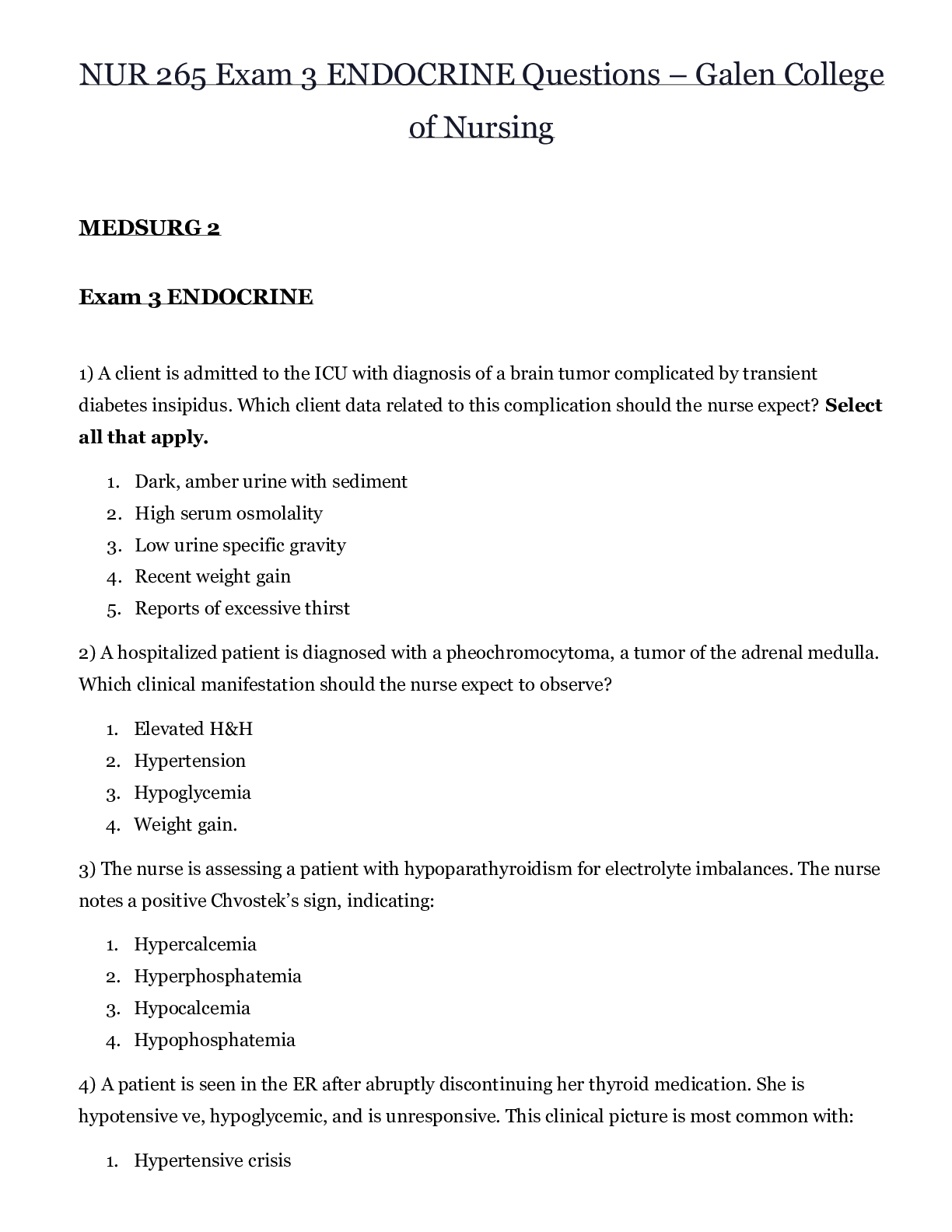
 – CHAMBERLAIN COLLEGE OF NURSING.png)
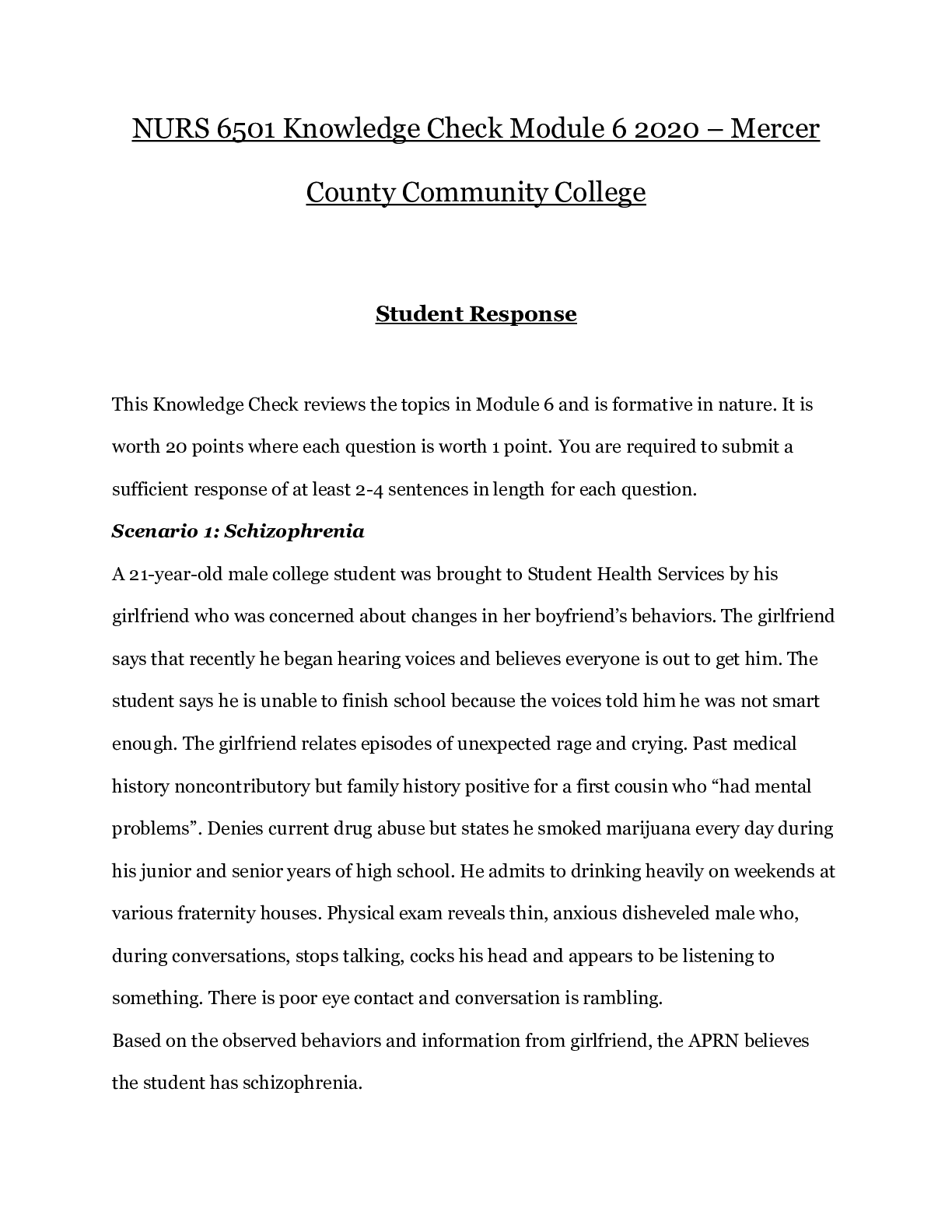


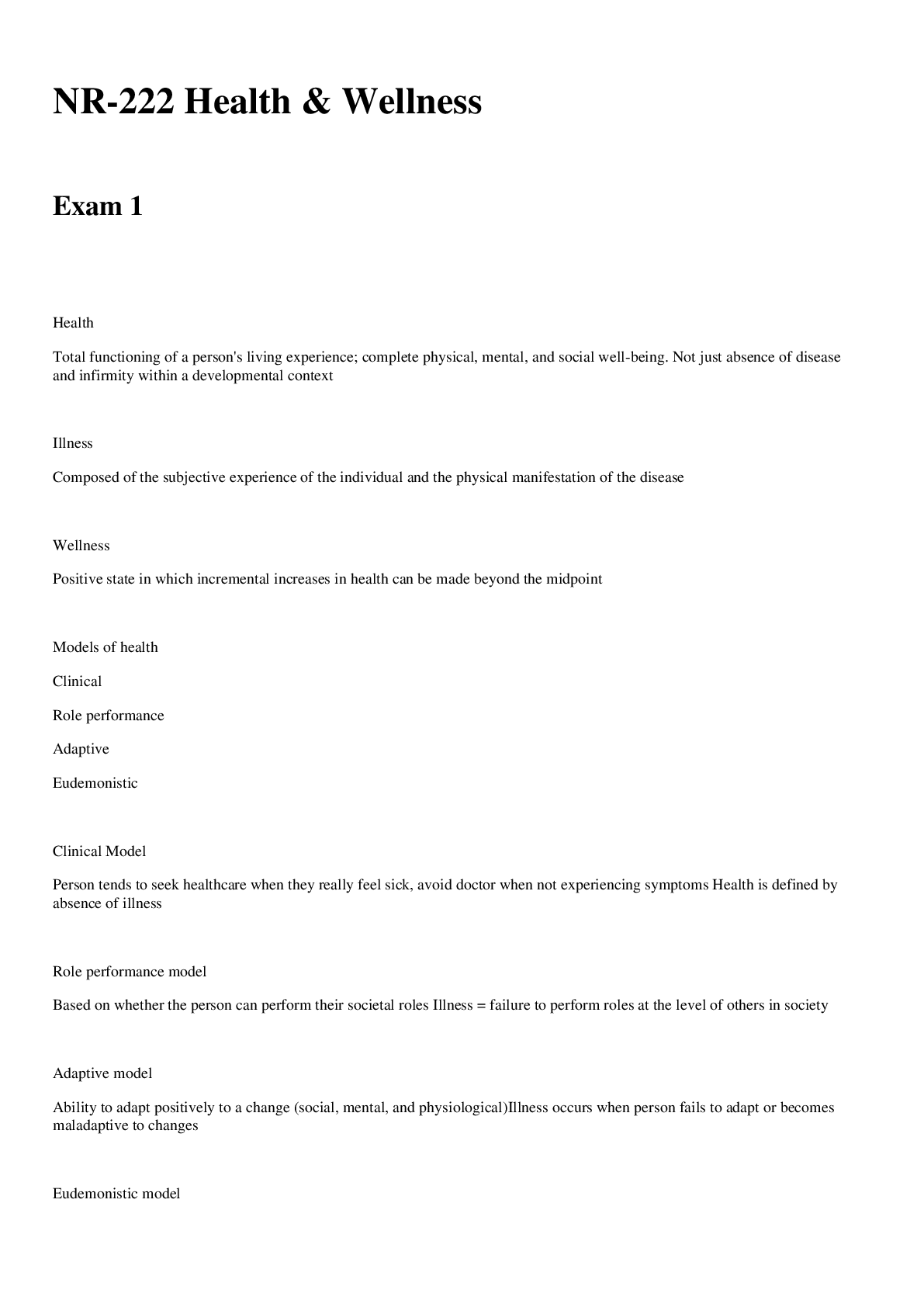



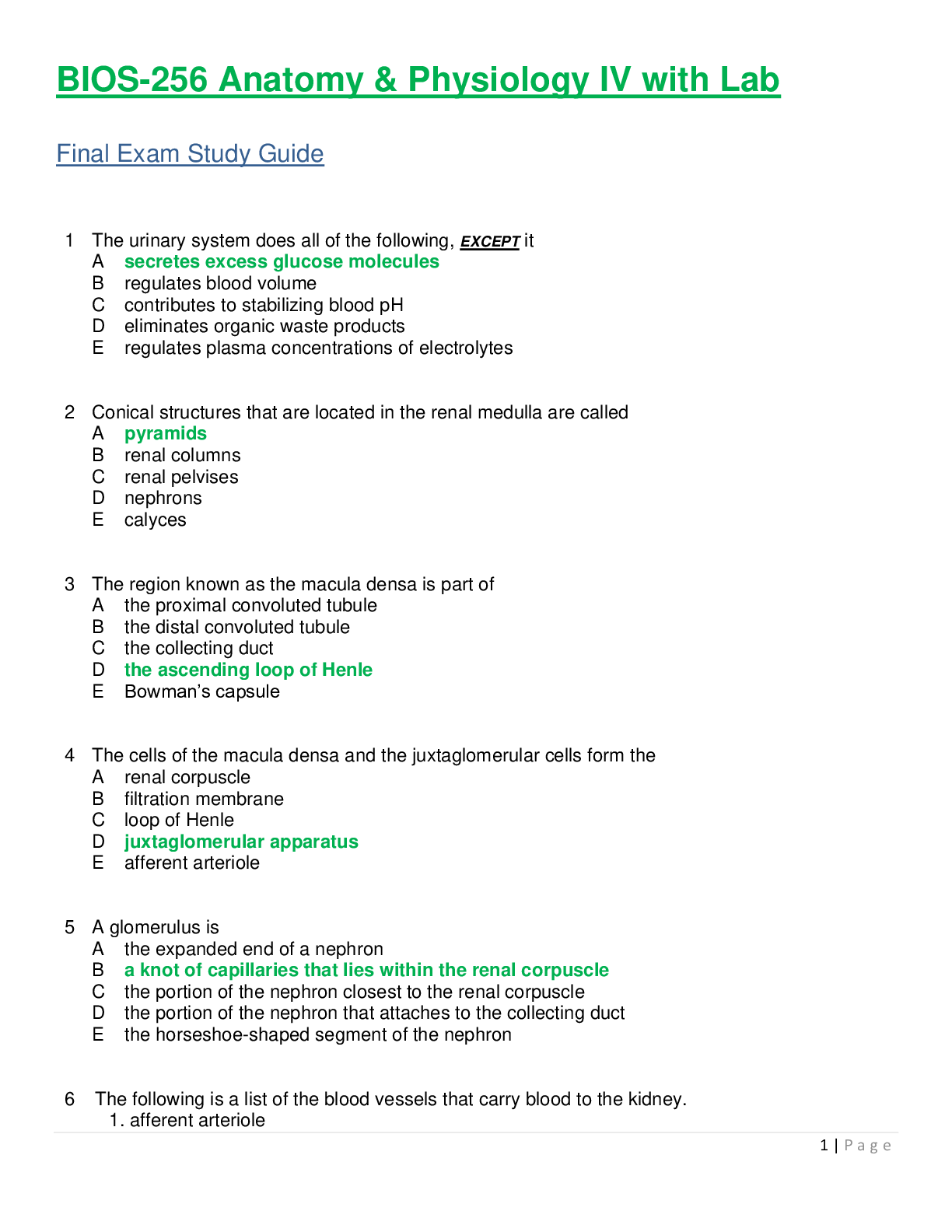

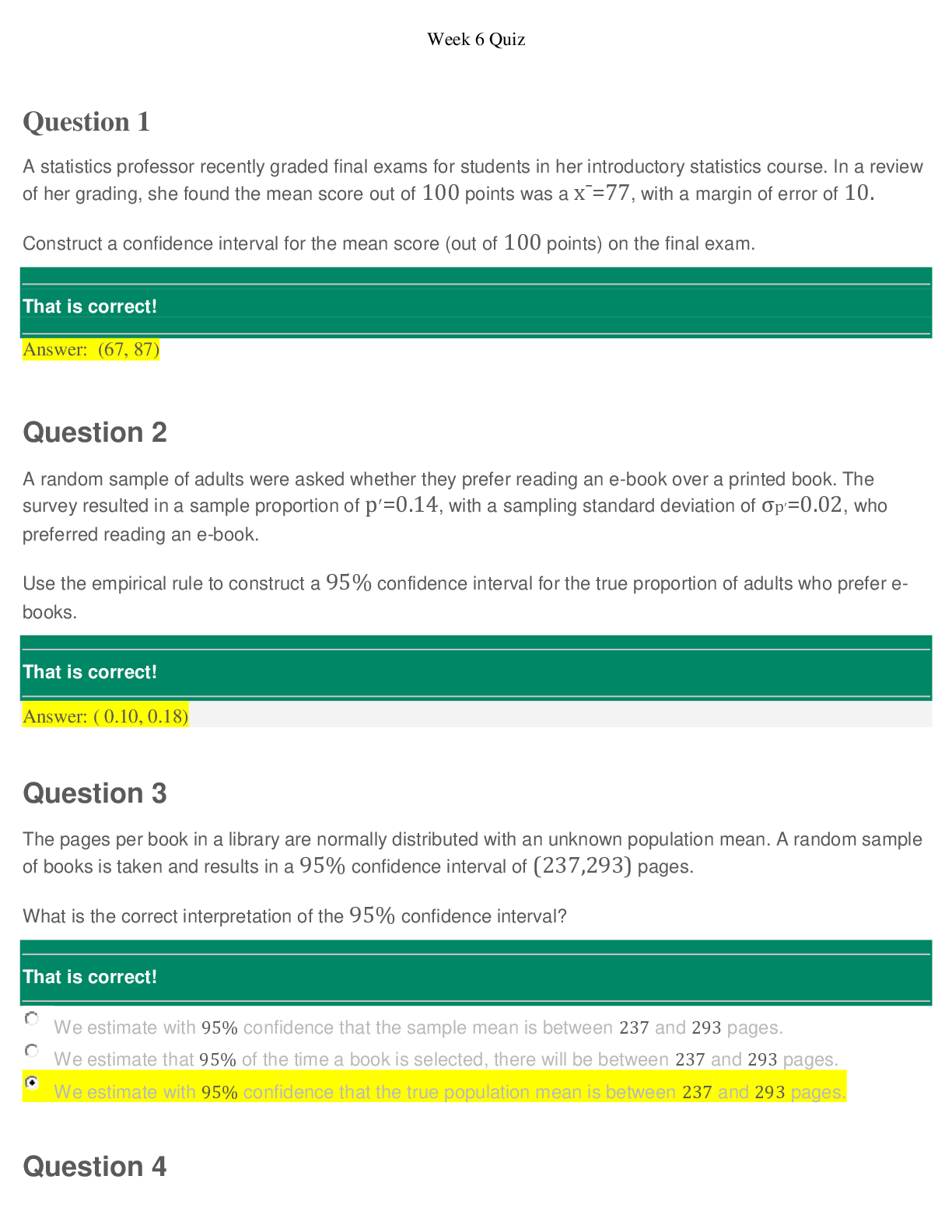



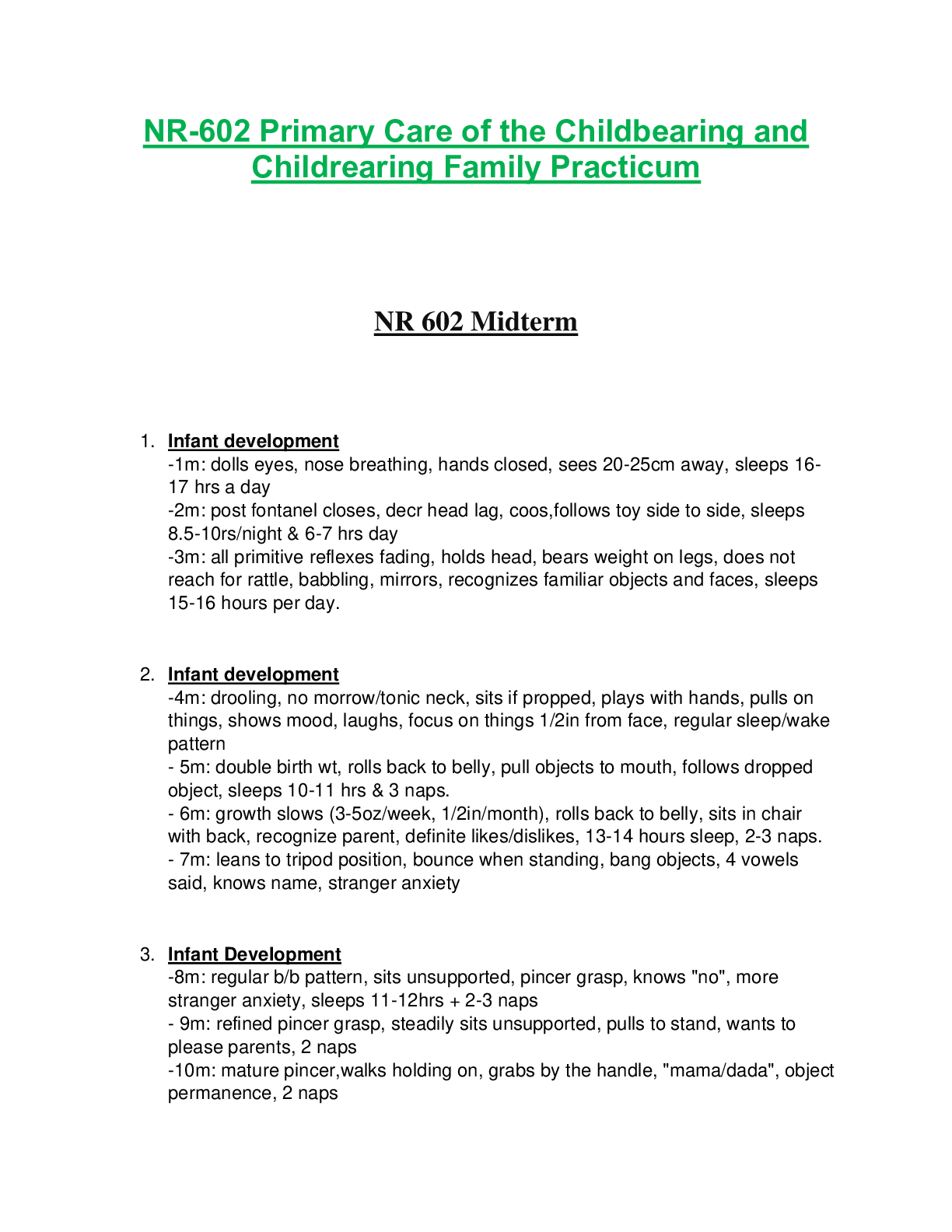
 – Chamberlain College of Nursing.png)

